by Daniel Combellick
*New Photos added
The house began with ordering 60 logs from the forest service, which they delivered to the site. Common Fir. Some of these I used to build a small hut, which were all hand-hewn, along with some Birch logs taken from my forest. I lived in this small 12 X 16 ft hut the entire time I was building the house.
The foundation was dug by hand, and filled the same… this was one of the three procedures on the house I had help with – the other two were installing the metal roof, and hanging the drywall – besides these all work was completed by me. In my shed there was no electricity or water – the water I brought in containers in a wheel barrow, or on a sled in the winter – from a nearby farmers well, the old kind, drawing the water with a bucket on a chain and dumping into the old milk containers I used for storage. My light was from headlamps, and kerosene lanterns. I had a propane stove, an outhouse, and an outside bathing shelter.
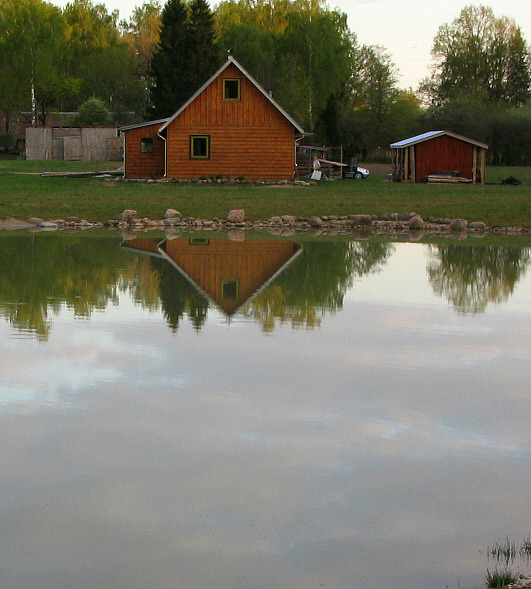
When I had completed my lumber take-off I sent the logs to a mill and had them sawn. Then, I commenced building. I was alone almost every day, this is a very remote spot, it is very quiet. Sometimes the loudest sound above that of my tools was the flap of a bird’s wings overhead. Did you know crows are very noisy fliers?
I used a modified timber frame system of my own design. The windows and doors were produced by local craftsmen. All hand made.

Winters are long and dark here which slowed me down, but after three summers the house was complete(enough to live in), and had electricity connected. Under such conditions one becomes very intimate with a sharp hand saw. I had them, but still remember counting strokes on the rafters… 144 strokes on the 45 degree cuts….
The principle of the house is very simple. The exterior is light and insulated, the interior walls are all brick, and the floors are insulated concrete. So when this house is warm it stays warm a long time, and in the summer it never needs air conditioning. There is just too much thermal mass for quick temperature fluctuations. The brick stove, which is also the heat source was adapted from an old book lent by a friend called “How to Build a Country House” written in Russian, but with good enough illustrations I could follow it. It is amazing, in that the smoke leaves the stove lower than the fire, but it does not end there. Behind it is a thick brick wall where there is a serpentine chimney. The smoke passes through this chimney heating up, literally, a ton of bricks. In warmer weather there is a damper to open, to allow smoke to go straight up and out. I was very skeptical of this as I was building it, coming from an American background and knowing how they vent fireplaces…. but it works, and works very well. There is never a scent of smoke in the house. Indeed, you will find most country homes here have variations of this same technology, hundreds of years old. And my chimney had added one luxury. On one side of this “warm wall” is the shower, so when you are in the shower there is wonderful radiant heat.
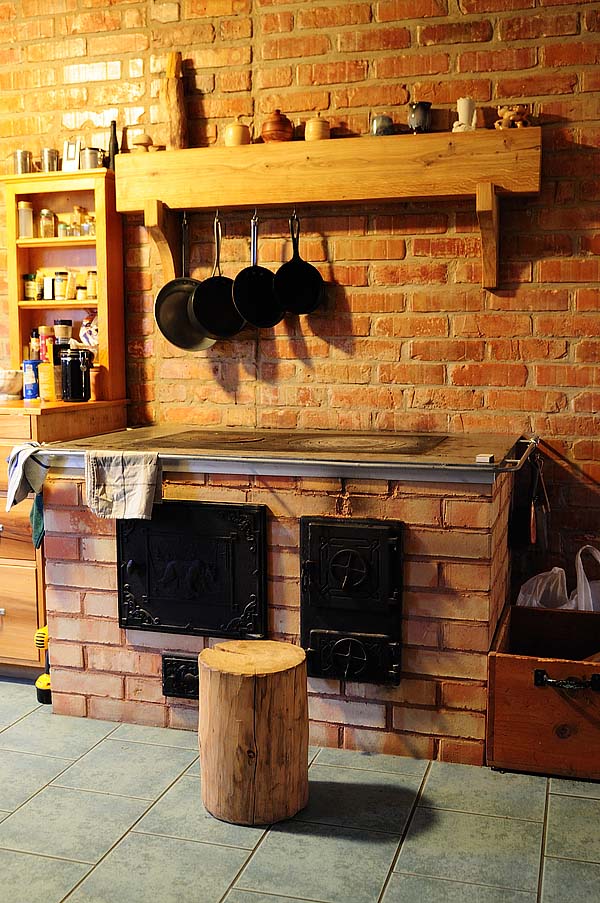
So there it is. The lower level is about 500 sq ft, and the upper level less than 300. It is very comfortable for two people, but a family of four would do well.
I have just recently bought another property here in Lithuania and am hoping to repeat this process soon.

I am sending you a picture of the stair, the posts for which were made from a single birch tree that was carefully skinned. Behind it, as in more plain in the second picture, is the warm wall with the serpentine chimney inside. In this one the direction is side to side, but often they are made with the channels going up and down.
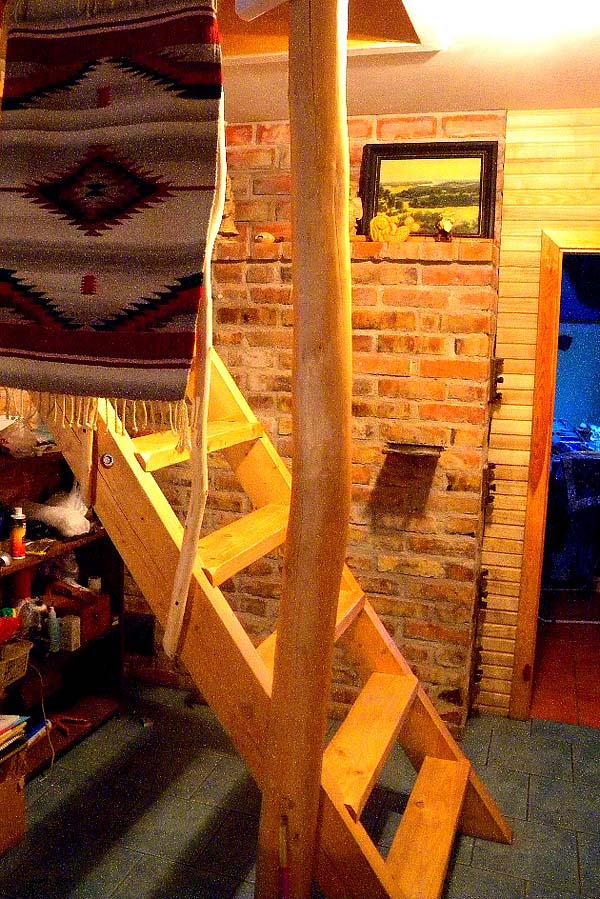
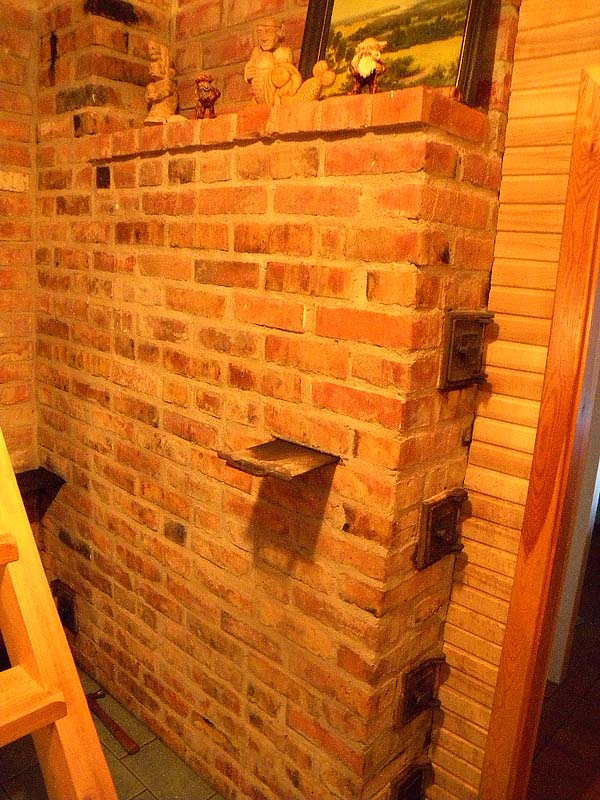
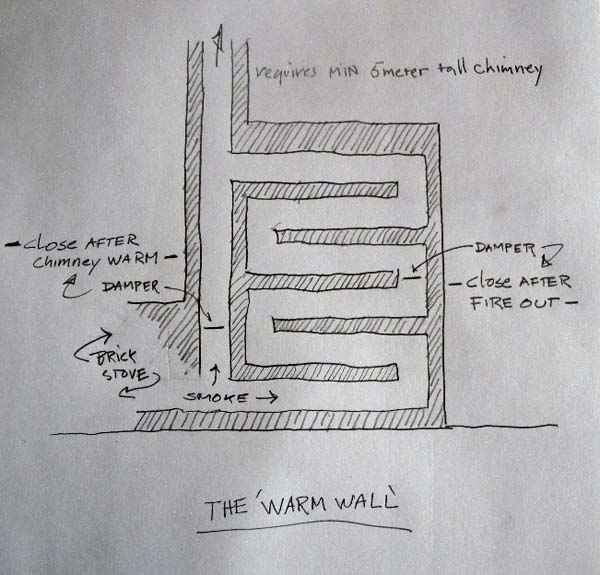

I would love to see more photos and of the stove as well I want to build a similar house in the is of a more Bavarian style
What a lovely brick wall in the kitchen! That book “How to Build a Country House” I would like to read, too.
Also, I think the “hut” has a very nice staircase (beautiful foundation).
Gorgeous! I agree – more pictures please!
If you’re building another one, I hope you’ll create a blog to show your process. Your cottage is about the same size as one I’d like to build though I’d not considered brick walls inside as I’m looking at straw bale walls.
You’ve build a beautiful home, you must be very proud to have done so much of it yourself, congratulations.
Combining masonry walls with walls of straw would be tricky due to the difference in rates of “settling”. A masonry stove coupled with a warm wall could still be incorporated, as long as the warm wall does not reach anywhere near the ceiling height. The warm wall is relatively easy to build, and could be combined with a “normal” wood stove easily enough- the trick would be to be certain there is a straight-up path for the smoke that can be dampered after the chimney is heated- it is all common sense, really. Not too many tricks about it. In any event, adding interior thermal mass is only going to improve the stability of the temperature, provided it is not done in such a way as to become a possible conduit for cold. One major alteration from local customs I made was to end the masonry chimney inside the house, and take it through the roof with stainless steel, to prevent the bricks from becoming just such a conduit.
I’ve been thinking of either brick or concrete flooring with interior walls of brick or earthbag for thermal mass inside the insulated outer walls. Been thinking of a masonry heater/stove in the center for additional thermal mass and heating which would keep the mass separate from the insulation.
Settling shouldn’t be a problem as I’d plan to timber frame with strawbale surrounding the frame.
Some great ideas in your house.
I have considered this idea of combining straw with a rigid frame. I keep coming up with how to address the void that is going to develop wherever the “top” of the hay is. I am sure it can be dealt with, I just have not figured it out. That- and I am lazy. When doing everything myself, I often will choose the path of least resistance. Rock or glass wool does have it’s advantages in this case. Other concerns I have with the hay is vermin, keeping it dry… Balancing speed of installation against cost… it can become a serious issue… sometimes- I over-think things. Like- what if- at the top of the wall, there was a removable board or crown, giving one the means to- after some time- check and fill if necessary? I am very interested in your progress. By the way- here in Lithuania they used to produce lots of linen. The husks left over from the manufacturing were used for insulation- very cheap- and very durable- I have seen it quite dry and clean and serviceable in a couple old houses… Thanks for comments!
Hi, Interested in the heater / stove, Think it could be accommodated into my 1940s house which had the original ceilings, and could do another in kitchen for cooking, if there was more information. This is the closest I have come to something where I could possible convert my wood heater into a serious heater, especially I have the tall chimney, Thank you for you time,
Blessings from OZ
Janina
Very very curious about the stove construction and the two pipe outlet.
I would also like to know more about the stove. I’ve heard them called many things, but wikipedia seems to call them Russian Ovens: http://en.wikipedia.org/wiki/Russian_oven
That is as good a name as any. Here they are called “krosnys”. It vents through a six-inch flue, which, when you imagine what the building codes in the USA require…. well, I doubt they would allow this tech. It is laid up with clay mixed with sand. I made some alterations from the Russian plan, increasing the firebox size, and adding firebrick lining here and there… It has been in use now for 6 years and is doing great. The radiant warmth greets one very kindly when one enters the house…
Masonry heaters are great, my mom had them growing up in the mountains of what is now Slovenia. They had built-in shelves where the smaller kids would sleep on the coldest nights. There’s some info at http://www.mha-net.org/html/gallery.htm for some similar things.
Ah – yes. I have three “tile stoves” in my current (18th century) house, but they look more like the top photo in http://en.wikipedia.org/wiki/Masonry_heater (except two have a rectangular base, not round). They are pretty very efficient for storing heat (even during swedish winters).
An oven structure that is more “built-in” into the house structure, and with larger thermal mass, would be even better for storing heat, though. I really like the idea of combining it with interior walls!
replying to:
“An oven structure that is more “built-in” into the house structure, and with larger thermal mass, would be even better for storing heat, though”
Have you ever tried to cook on wooden/country stove and to compare to cooking on electrical/gas? the same applies for baking, plus add economy for baking at the same time when heating the house, when not only gasoline, but electricity is high here, when compared to wages locally and world wide prices, then the thermal mass, which already big enough, is not the matter anymore and the oven is a really good decision. i wish for more good decisions though.
Greetings from Lith.
More info on contraflow heaters with some diagrams showing the “guts”.http://www.sarnomasonry.com/technical_notes__links If you google contraflow heater and choose images there are lots more to look at.
Gorgeous; I love it. Can you share more photos, and possibly a bit of your plans? It’s beautiful.
Thank you for sharing your story! That location looks incredibly peaceful. I love the idea of being able to build my own home.
i would love to read that book.
Dan,
Your home is beautiful. Thanks for sharing. I assume that your bedroom is in the 2nd Fl. Would you be willing to build exact the same home as yours except that the bedroom to be in the lower level, if someone asks you to build for them instead hiring other contractors?
where is it that you wish to build?
Dan,
The place I want to build is in Massachusetts. 5 miles from Worcester.
Great article. You should be very proud.
How did you get the logs from the forest service and how much did they cost ?
It was very simple. You go into their office and tell them what you need. Here it is not necessary to be a giant corporation to buy from them. The cost was around 10 cents a board foot. It was almost free. Lithuania is a very nice place to live. Their language is difficult to learn, but any attempt to speak it, coupled with a smile, will win you help and great praise as to your abilities in speaking.
I’ve been to Lithuania. It’s a beautiful country, and the people are very friendly, but it can be difficult to find someone who speaks English. Most older people speak some Russian, and in more touristy locations some German can be helpful, but although I was only there for two weeks, I tried to learn some Lithuanian because it was hard to get by without it.
Your house is absolutely beautiful by the way! I would love to see more of its design.
Nice design and hand work, Daniel. I would like to connect you and other blog readers with my nephew, Carsten Homstead’s, website regarding masonry heaters he is building for residential use in Western Massachusetts. He is part of an organization of masonry heater builders, link on his website: http://www.homespunworks.com/homs/HOME.html
I’m so pleased to hear about the resurgence of masonry heaters and hand crafted shelter.
You did a great job, Daniel! 🙂
Thank you, and everyone, for all the kind words. I have been building houses since I was 16 years old out in the mountains of Montana. This is by far the smallest house I ever built, but it is my favorite, and also the most comfortable to be in. Indeed, for my next project I am drawing up an even smaller plan.
Great project. thanks for sharing it with us.
Very nice job and house Daniel,
I wish to build one like this but half or twice longer, what we call “Longère” in France. These houses were the typical kind of paysan’s house with cows or sheep at one side and inhabitants at an other side.
The structure, the mix of wood and bricks is interesting and like others I’d like you to share more photos and plans.
thanks for sharing with us !
It’s a lovely design with such great craftsmanship. I too would like to see more inside pics. Also I’m always curious about the person behind the story. Could you elaborate a bit? Sounds like you grew up in Montana? So how did you end up in Lithuania and do you speak the language fluently?
Its a long story covering several states and a wide variety of projects, from horse barns to exclusive golf clubs, from dog houses to multi- million dollar homes. I was hired as a consultant for the construction of the first western style home to be built in Lithuania in 1994. I fell in love with the place, and moved here in 2003. My experiences gave me contacts with some of the finest craftsmen in the USA, and I am always curious and asking questions, and I, over the years, learned how to do everything. Predicting the housing crash, I left the formal business when I moved here in 2003, and since have been building for myself as well as doing consulting work here and in the USA. I am finished with construction for often difficult clients, and now approach it from the love of doing it. I Started as a carpenter in 1974 in Montana, (originally from Iowa) then took a turn at a university in Architecture and Structural Engineering- not with the intent to practice either, rather to learn how to build. Since then, well, as I said, it is a long story, and I fear I have already written more than is interesting. Thank you for your question.
http://www.mainewoodheat.com/ This site has wonderful images, information on wood fired ovens, masonry stoves, and cast iron hardware for stoves and ovens. If nothing else the images are great!!
Beautiful house and great to see a place outside of USA.
Dan, my family is from Lituva and I still have relatives there. My Uncle has a dacha in a similar style on a lake outside of Vilnus with a sauna/bathhouse facing a long dock for plunges.
The family was from a place called Ukmerge? (Spelling). I have been there once a few years ago and remember the endless forests, the mushroom and berry hunts and the great local beer!
Yes, Ukmerge. I have been there many times, and pass it frequently on my way to and from Vilnius. My new property is near Vilnius as well, just 30 minutes from the center. Vilnius is my most favorite city I have ever been to, and if I were going to live in a city that would be it, but I am a country boy I guess. Yes.. Lithuanians are crazy for beer- in Birzai, near where this house is- a small town of 12,000, there are 4 breweries! Did you try the Stiprusis? their 8% beer? Talk about packing a wallop!
by the way, anyone is free to email me at dan@danielcc.com
LOVED this article/house! And the hut’s cute, too, would serve wonderfully as a ‘guesthouse’, now that your home is ready to live in… Thank you for sharing. If I had the ‘ducks-in-a-row’ right now, I, too, would be contacting you to be my ‘personal builder’! Your craftsmanship gives what you build more personality, more charm, more LOVE, than what one typically gets from most ‘cookie-cutter’ contracters, because even the best of them cannot imbue the ‘soul’ you so obviously build into YOUR wprk. It’s a talent that one must be BORN WITH, I think. 😉
You are definitely born of some mighty fine, winsome and charming ‘soul’!
Ah, if only I had those danged ‘ducks-in-a-row’, though…
This was so interesting – I never thought of actually lining a wooden structure with brick. Very clever.
The heat stove/system reminds me very much of the “Kachelofen” of the Alpine regions of Bavaria, Austria and Switzerland, where we have a LOT of tiled stoves. They are still popular. Great pictures if you google “Kachelofen” or “Hafner” (the name of the person who is specialised in the skill of making these stoves!).
I didn’t know they had this kind of stove in eastern and northern Europe at all!
Sorry, that would be “Hafner ofen” for a search.
Lovely home, and hope the place stands long and has happy inhabitants. I can see a nice garden and some animals in yard already!
One of the most informative and fascinating posts here ever. I have always loved the idea of masonry furnaces, but to use the concrete floor and brick interior walls is just brilliant.
If you don’t need to make money from the information you could provide in a blog, and are comfortable doing so, blogging through your next build would provide such an education opportunity for all the people who haven’t quite been able to escape their mundane work-a-day lives and may provide a chance for them to do so in the end, becoming the personal builder for others that you don’t want to be.
I’m such a newbie and visual person I always seem to need more background info when coming across something new like this. Living in northern Ohio and not getting any younger the winters seem longer every year. As a result I have often been interested in the art of heating oneself in cooler climates/environments with an eye on efficiency and eco-friendliness. I was trying my darnedest to find that Russian book, “How to Build a Country House” to no avail but did come across this URL:
(http://www.lowtechmagazine.com/2008/12/tile-stoves.html)
that provided some help i.e. “get off the ground info” for others as perceptually challenged as me. It also has further reference links which while I have not yet explored, seem to be promising. Hope it helps others.
You wont find it. The book is at least 50 years old and out of print. If you don’t mind long winters, move to Lithuania. 🙂 The summers make up for it… around the solstice it never gets quite dark at night… the day’s are incredibly long, and the weather as nice as you will find on this planet, in my opinion. The only really costly thing here is gasoline. That hurts. But the public transit is quite good. Well, you know I like it here!
Hi Dan,
I am curious why you chose the Vilnius area for your home. As you say – and I agree – Vilnius is a beautiful city. My husband and I were there in the summer of 2008. Also traveled to Butrimonys and Kaunas, Marijampole and thereabouts. My father was born in Vilnius (Vilna, back then) in 1908 and most of his family lived there. Many died there as well – long before their time. I hope to return to Vilnius soon – possibly next summer.
Anyway, would love to see more photos of the interior of your home!
Best regards,
Danielle Weiner
Dallas, TX
To be close to Vilnius. The house in this article is near Biržai, which is far away from everything. plus- it is pretty countryside here- the only drawback here is that I am in a Polish region…. and some people don’t even speak Lithuanian! Which I am barely learning. I have a nice lot on a hill(11 acres), and can see the sun rise and set, and my closest neighbor is about a kilometer away. I like the solitude. But, in 30 minutes I can be in the capitol city.
This was alot of fun to read, Dan. Thanks for sharing publicly your home building adventure. You have gotten nice responses to the article! Good on you!!
It’s very beautiful and peaceful and you must be very proud!
Dan – Lovely house and article. Enjoy the pics but would love to see more. I had wondered what took you to Lithuania. Enjoy… and keep building. : )
Really nice house you have there, Dan 🙂
And it is so moving to read nice comments about our country, by American people!
Hi Dan, hi everybody 😉
I was also enjoying reading the article of american in Lithuania and all the comments about it! 30 mins from Vilnius in our country means a loooot far away from the city, especially in this polish side. And it is hard to believe, that somebody could call our country to be nice place to live, but yeah… maybe… We don’t have no earthquakes, volcanoes or deadly hurricanes – just miles of forests and fields. And living in Lithuania is not cheap, for sure, especially when you get the lithuanian wage. But our parents can manage that, the younger generation, though, often look for the better places in the world. But if somebody is looking for a quiet or old-style place to live – then lithuanian countryside is perfect for that! Even if you don’t know the language – I wouldn’t agree that we barely speak english ;).
very nice house, But it don’t look all that small to me..Appears very average in size for the typical regular houses…
Sweet little home. Thanks for sharing!
First Awesome house. I love all the places on this blog. Second, The Russian fireplaces are very prone to flu fires. I have personally seen three of them and all three of them where trashed from fire. As smoke moves through it creosote is deposited because the smoke cools considerably more than a typical flue and also the horizontal runs create more friction leading to additional deposits. Additionally, they typically cant be cleaned because there is no access to the horizontal runs. I think its a great idea and have thought about building one myself but building clean out’s on the end of the horizontal runs to keep it clean.
As you can see if you look at the pics. Plenty of clean-outs. Anyway, it has not been a problem at all. Much depends on the wood used, and the fire temp.
Inspiring! How did you treat the outside wood panel to get that orange-y look?